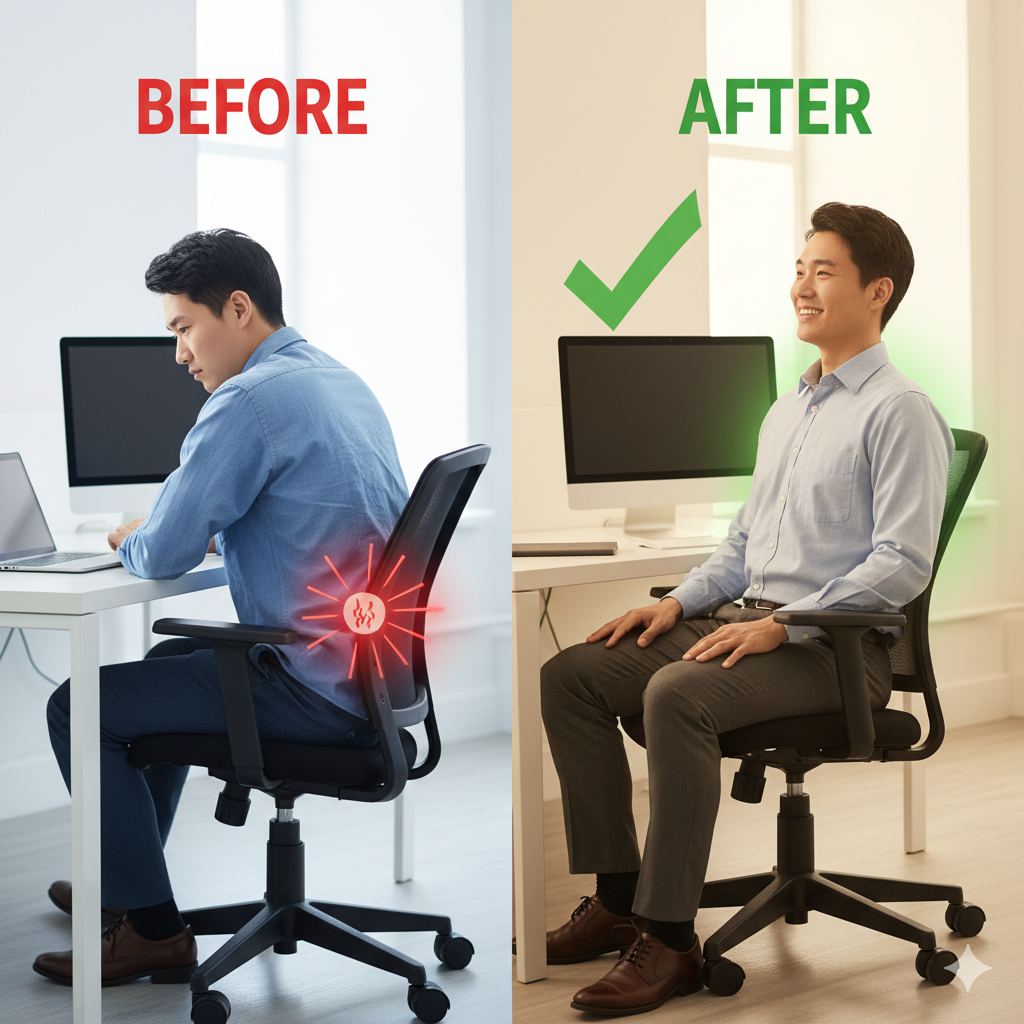It starts subtly. A dull ache in your lower back around 4 PM. Shoulders that feel like they’re carrying the weight of the world. A stiff neck that cracks when you turn your head. Before you know it, this discomfort becomes your daily normal, a built-in consequence of your desk job.
If you spend the majority of your day seated, you’re in a constant battle with gravity and poor posture. Our bodies are designed for movement, not for being folded into a chair for eight-plus hours. This static position weakens crucial support muscles, tightens others, and puts relentless pressure on your spinal discs.
But what if you could fight back without overhauling your entire life?
Good news: you can. As physiotherapists, we know that the most powerful solutions are often the simplest. This guide will give you 10 actionable, science-backed strategies to protect your spine, prevent back pain, and make your workday significantly more comfortable.
1. Architect Your Workspace for Success
You wouldn’t build a house on a shaky foundation, so why work from a setup that undermines your spine? Your desk, chair, and monitor are the tools of your trade. Optimizing them isn’t a luxury; it’s the absolute first step in back pain prevention. Let’s build your perfect ergonomic bubble.
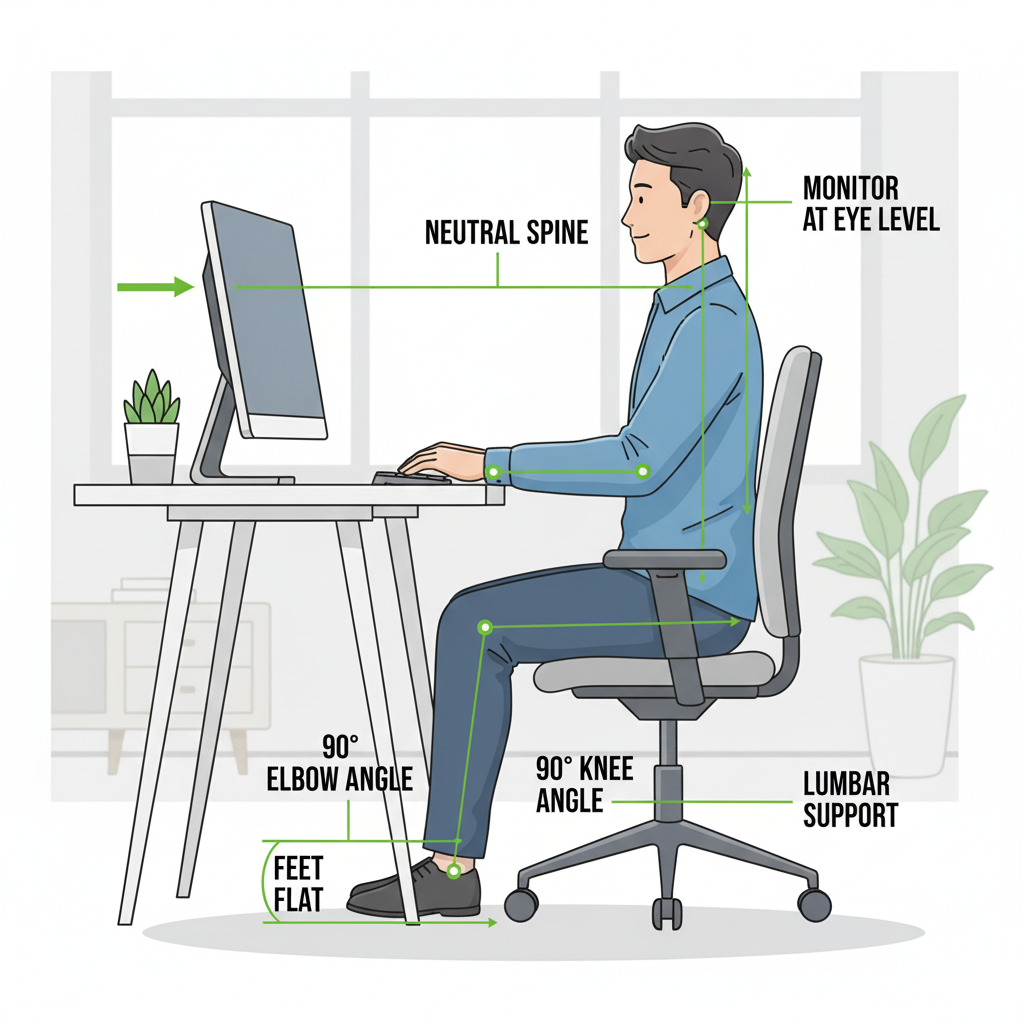
- Elevate Your Gaze: Your monitor should be positioned so the top third of the screen is at your eye level. This prevents the dreaded “tech neck” slump. Pro-tip: a stack of textbooks is a physiotherapist-approved (and budget-friendly) monitor stand.
- Create Right Angles: Your chair height should allow your knees to be bent at roughly 90 degrees with your feet flat on the floor. Similarly, your elbows should rest at a 90-degree angle when you type. This keeps your joints in a neutral, low-stress position.
- Embrace Lumbar Love: Your lower back has a natural inward curve (the lordosis). Your chair should support this curve. If it doesn’t, roll up a towel or a sweater and wedge it into the small of your back. Your spine will instantly thank you.
Why it works: Ergonomics is about creating an environment of minimal resistance. When your body is properly aligned, your muscles don’t have to work overtime just to hold you up, freeing up energy and preventing strain.
2. Become a ‘Movement Snack’ Enthusiast
The most dangerous posture is the one you stay in for too long. Your spine and muscles need variety. Think of movement not as a one-hour gym session, but as small “snacks” you feed your body throughout the day.

How to do it: Set a recurring alarm for every 30-45 minutes. When it chimes, your only job is to change your position for 60 seconds. Stand up, stretch your arms overhead, walk to the kitchen for water, or simply march in place.
Why it works: Movement is lotion for your joints. It lubricates your spinal discs, boosts blood circulation to your back muscles (delivering oxygen and clearing out waste products), and prevents your hip flexors from becoming stiff and short.
3. Activate Your “Inner Corset”
Your core is more than just the “six-pack” muscles. It’s a 360-degree muscular corset that wraps around your midsection, and its primary job is to stabilize your spine. The best part? You can switch it on right now, without anyone noticing.

How to do it: Sit tall. As you exhale, gently draw your lower abdomen inwards, as if you’re trying to button a slightly-too-tight pair of pants. It’s not about sucking in your stomach; it’s a gentle tightening. Hold for 5-10 seconds while breathing normally. Repeat 10 times every hour.
Why it works: This activates your transverse abdominis, the deepest core muscle. When this muscle is engaged, it acts like a weightlifting belt, taking significant pressure off your lumbar spine and discs.
4. Perform the Mid-Day Spinal Reset (Seated Cat-Cow)
Your spine can get “stuck” in that C-shaped slump. The cat-cow is a gentle physiotherapy favorite that flows between spinal flexion and extension, mobilizing the vertebrae and relieving built-up tension.
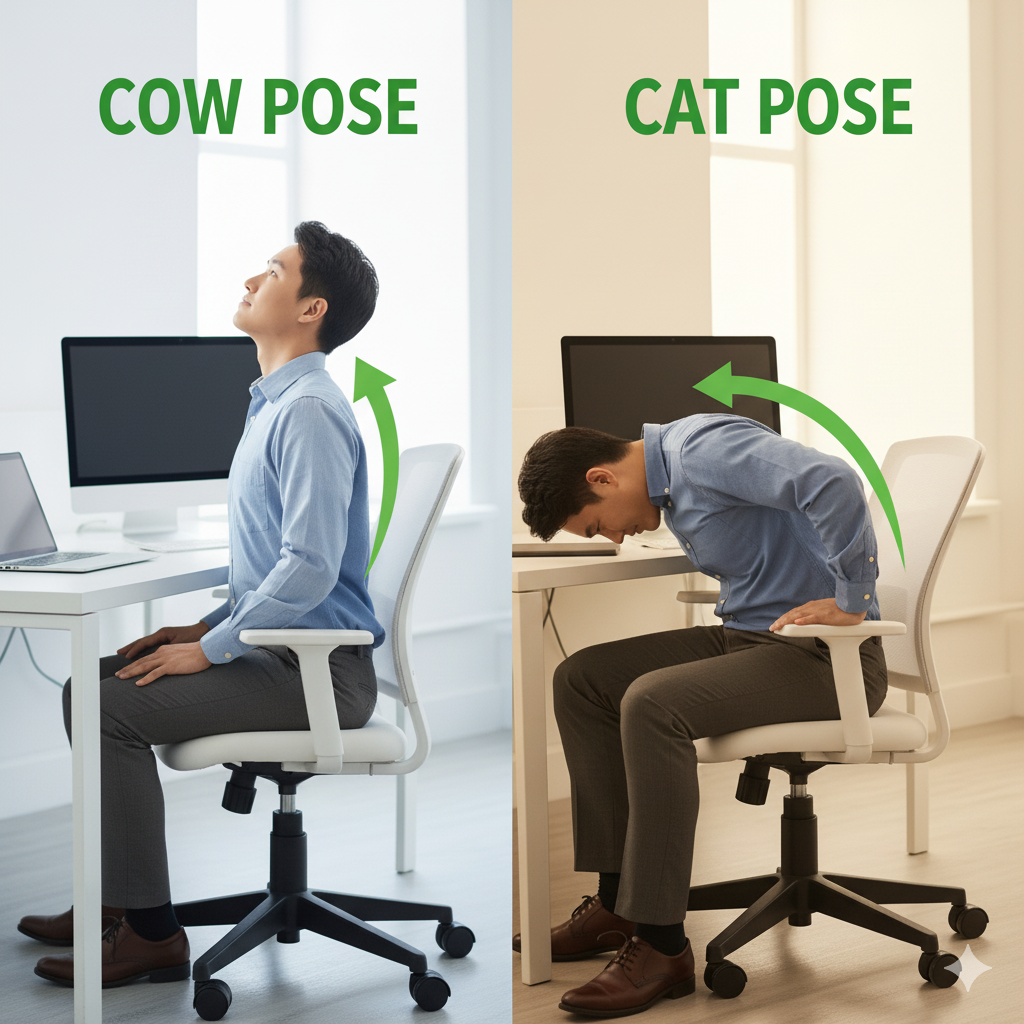
- Sit on the edge of your seat, feet planted firmly on the ground, hands on your knees.
- Inhale (Cow): Arch your back, push your chest forward, and lift your gaze. Think about creating space between each vertebra.
- Exhale (Cat): Round your spine, drop your chin to your chest, and pull your navel inward. Feel the stretch across your mid-back.
- Flow smoothly between the two for 8-10 breaths.
5. Un-Glue Your Hips with a Figure-4 Stretch
Here’s a secret many don’t know: your tight hips are often screaming at your lower back. When hips are immobile from prolonged sitting, your lower back is forced to compensate, leading to strain and pain.

How to do it: While seated, cross your right ankle over your left knee. Keep your back straight and gently hinge forward at your hips until you feel a comfortable stretch in your right glute. Hold for 30 seconds, breathing into the sensation. Switch sides.
Why it works: This stretch targets the piriformis muscle, a deep hip rotator that, when tight, can irritate the sciatic nerve and pull on the pelvis, disrupting lower back mechanics.
Myth vs. Fact: The Posture Edition
Myth: “I need to sit perfectly straight, like a soldier, all day long.”
Fact: Your next posture is your best posture. Trying to hold a single “perfect” posture is rigid and unnatural. The human body is designed for movement. Even a perfect ergonomic posture becomes detrimental if held for hours. The real key is to change your position frequently—shift your weight, cross your legs the other way, stand up, and sit back down. Variety is king.
6. Combat “Dead Butt Syndrome”
Yes, it’s a real phenomenon! When you sit on your glutes all day, they can become inactive and weak—a condition called gluteal amnesia. Your glutes are the powerhouse of your lower body. When they don’t do their job of supporting the pelvis, your lower back and hamstrings are forced to pick up the slack, leading to fatigue and pain.
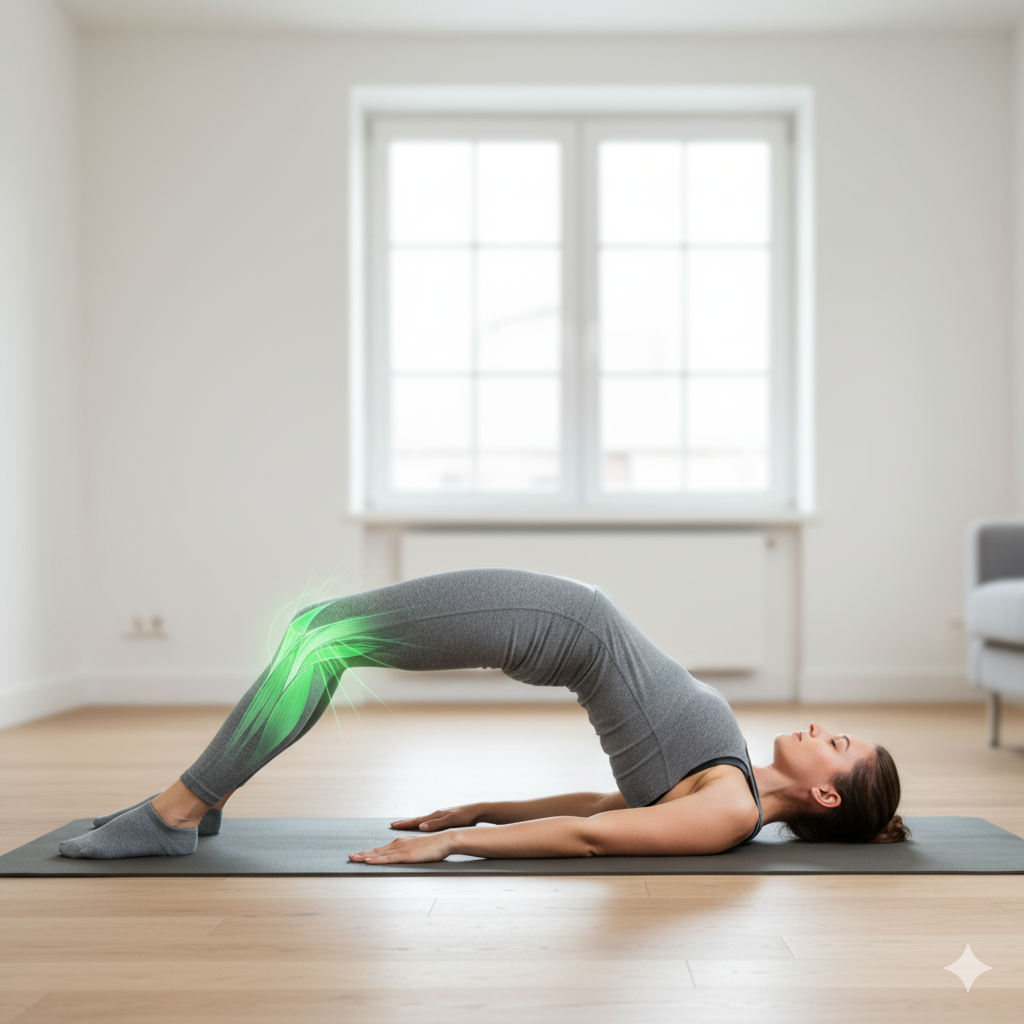
The fix (at home): Perform 2 sets of 15 Glute Bridges. Lie on your back, knees bent, feet flat. Squeeze your glutes to lift your hips toward the ceiling. Pause at the top, then slowly lower. This reminds your glutes what they’re supposed to do!
7. Hydrate Your Discs
Your spinal discs—the jelly-like cushions between your vertebrae—are over 80% water. Dehydration can cause these discs to shrink and become less effective at absorbing shock, increasing stress on your spine.

How to do it: Keep a water bottle on your desk and make it your non-negotiable desk accessory. Sip consistently throughout the day, don’t just chug water at lunch. Aim for at least 2 litres.
8. Reverse “Tech Neck” with Chin Tucks
For every inch your head drifts forward, it adds about 4.5 kg (10 lbs) of pressure on your neck and upper spine. The chin tuck is the single best exercise to counteract this.
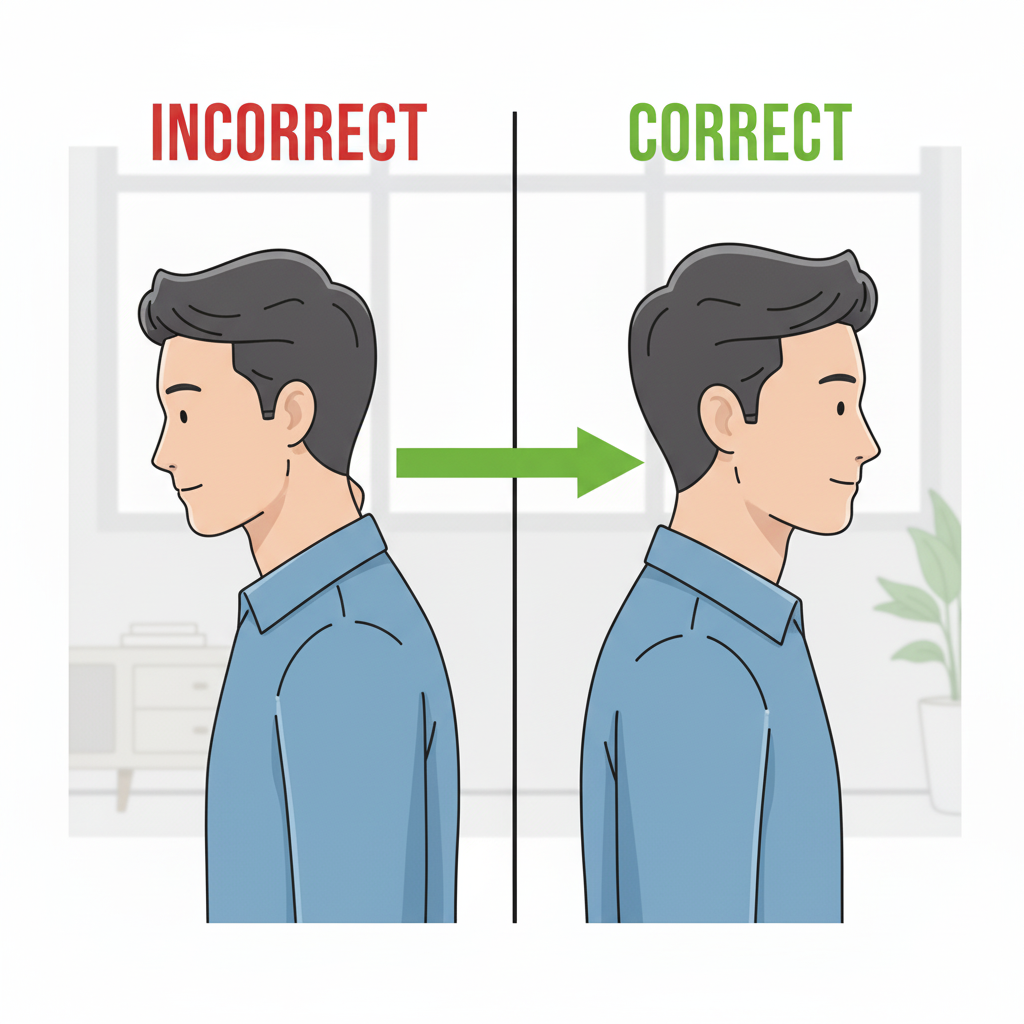
How to do it: Sit tall and look forward. Gently glide your chin straight back, as if you’re trying to make a double chin, without tilting your head. You should feel a stretch at the base of your skull. Hold for 5 seconds and repeat 10 times.
9. Move Like a Pro: Master Your Transitions
It’s not just how you sit, but how you get in and out of the chair. Many back injuries happen during simple transitional movements. Protect your spine by using the powerhouse muscles in your legs.
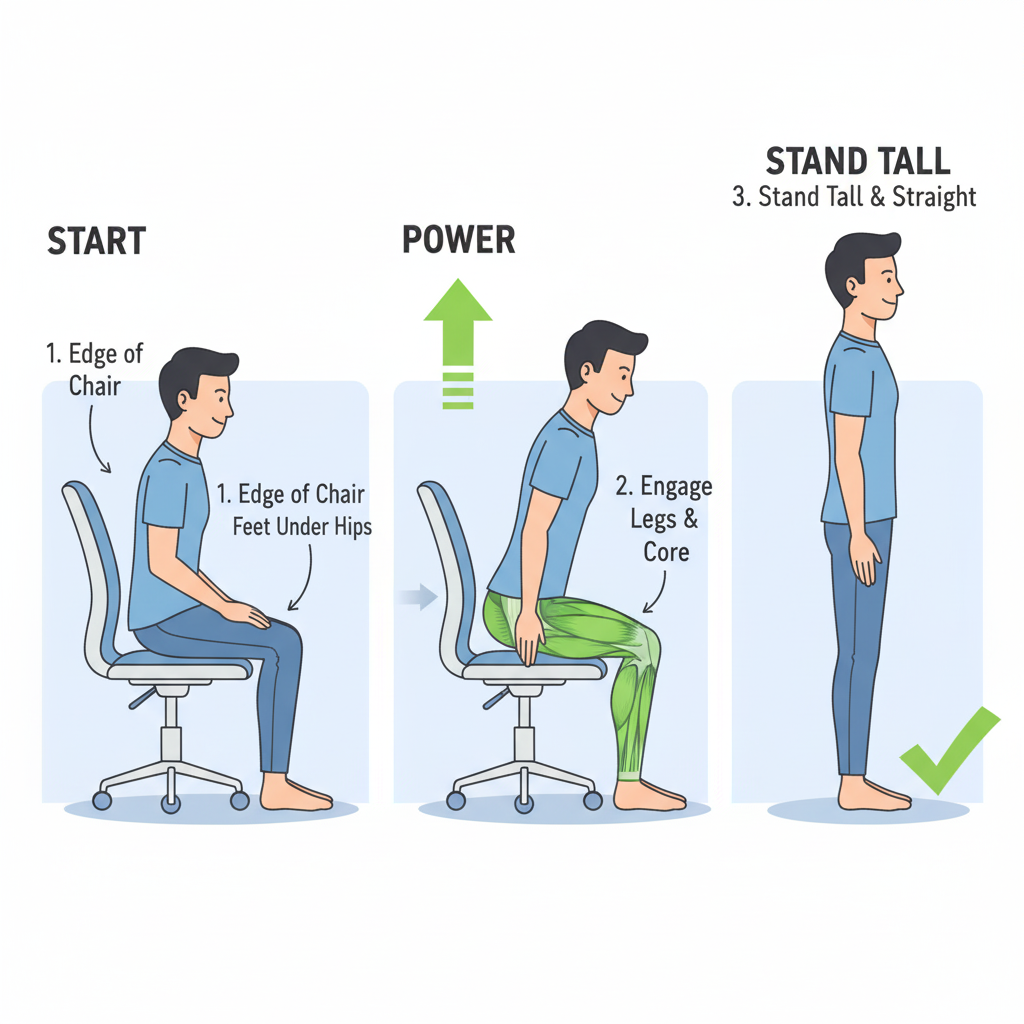
How to do it: To stand up, scoot to the edge of the chair, plant your feet firmly, engage your core, and drive upwards through your legs and glutes, keeping your back straight. Reverse the process to sit down—hinge at your hips and control the descent with your legs.
10. Just Breathe—The Right Way
Stress causes your body to tense up, leading to shallow breathing and tight back muscles. Deep diaphragmatic (belly) breathing is a powerful tool to flip the switch on your body’s stress response.
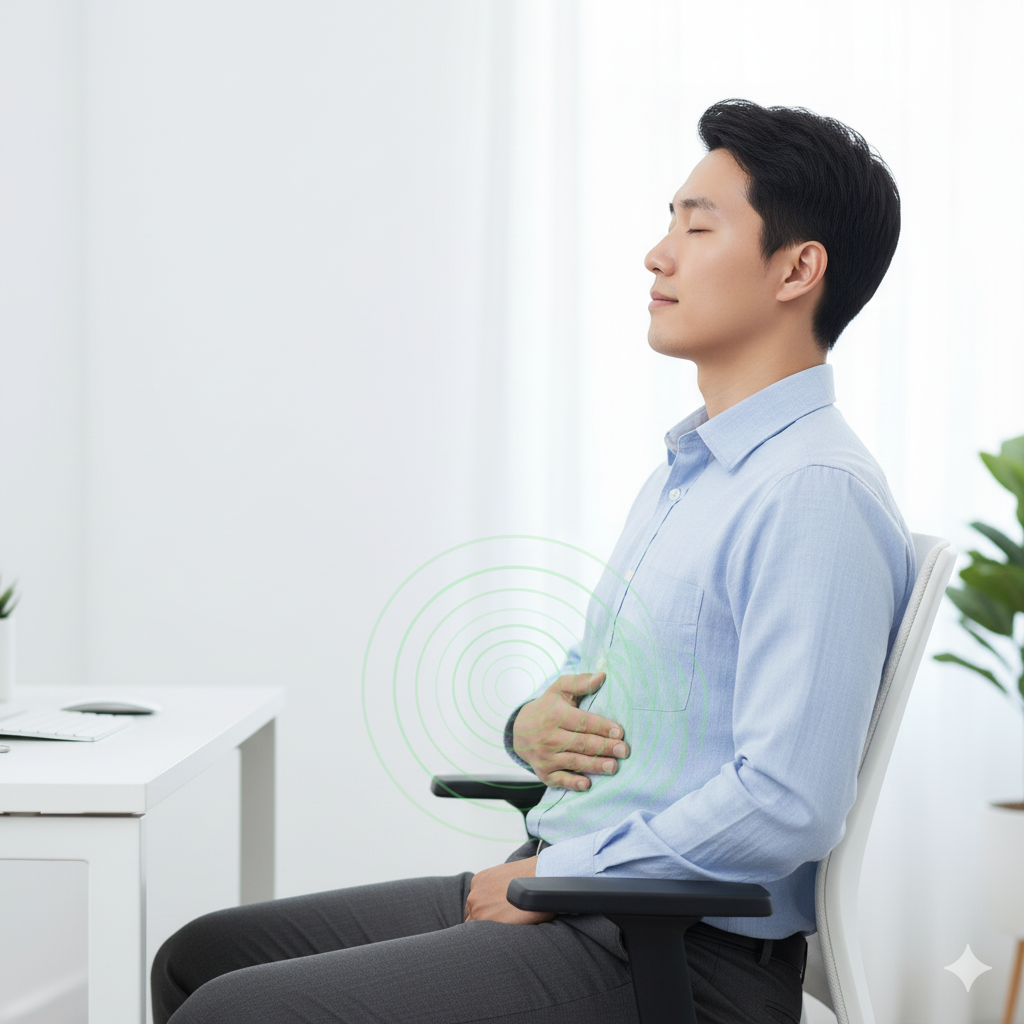
How to do it: Place a hand on your belly. Inhale slowly through your nose for a count of four, feeling your belly expand into your hand. Exhale slowly through your mouth for a count of six. Just 2-3 minutes of this can significantly reduce muscle tension.
Your Quick Reference: The Desk Worker’s Dos and Don’ts
| Do ✅ | Don’t ❌ |
| Change your position frequently. | Stay frozen in one “perfect” posture. |
| Use your legs to stand and sit. | Bend from your lower back. |
| Keep your monitor at eye level. | Hunch down to look at your screen. |
| Drink water consistently. | Wait until you’re parched to hydrate. |
| Perform micro-stretches daily. | Wait until you’re in pain to move. |
Your Action Plan for a Pain-Free Back
You now have a full arsenal of physiotherapy-backed tools to defend your back against the strains of a sedentary job. Don’t feel overwhelmed. The goal isn’t perfection; it’s progress.
Pick just one tip from this list to focus on this week. Maybe it’s the 30-minute movement alarm or the daily chin tucks. Master it. Make it a habit. Then, next week, add another. These small, consistent actions compound over time, building a resilient, pain-free spine.
Ready to get a plan that’s 100% tailored to you? While these tips are fantastic, a personalized assessment can identify your specific issues and create a targeted plan for lasting relief.
Visit Physiogain.com to book your virtual physiotherapy session today. Let’s work together to build a stronger you.
